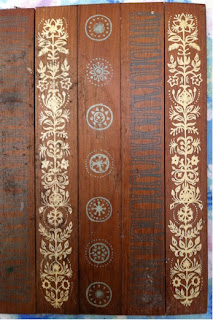In the 1950s, under the influence of Harry Jefferson Barnes (Deputy Director of
Glasgow School of Art, Dovecot's production expanded. Designer Robert Stewart (Head of School of Textiles, Glasgow School of Art) was recruited to start designing and producing tiles, printed textiles, placemats. He was assisted in this by a former student, Margaret Stewart (no relation).
The tiles were particularly attractive commercially as they had no purchase tax. Robert and Margaret designed a broad range of tiles, often in coordinating sets, which could be used on walls, fireplaces, or as table ware. The Edinburgh Tapestry Company Archives at Mount Stuart include a brochure of tile designs, showing each pattern in a number of different colourways, from which clients could place orders.
 |
| Tile Designs, Private Collection |
Placemats were produced in a number of materials. Robert Stewart developed 'blotting paper' placemats which could be used a number of times and then disposed of. These were designed with bright colours and strong graphic designs.
 |
| Blotting Paper Placemats, Private Collection |
Barnes was keen to expand these into tourist souvenirs, and a collection of topographical mats were produced an packaged in branded Dovecot sleeves:
Margaret Stewart developed an innovative folding table mat using decorated parquet flooring strips backed with green felt:
 |
| Detail of Folding Placemat, courtesy Sheila Stewart |
 |
| Design for Folding Placemat, Private Collection |
Dovecot is clearly a product of the people who have been involved in its running throughout it history. Harry Jefferson Barnes and John Noble, with their involvement in the Scottish Crafts Council, realised that tapestries alone were not sufficient to keep the company solvent. Their solution was to create smaller, more affordable, items, produced along the same principles of good design and craftsmanship which the studio had always followed.







